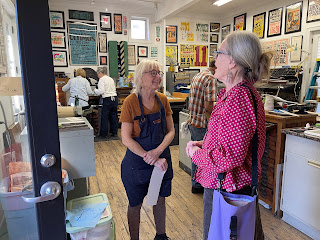Friday, November 22, 2024
Vintage papermaking moulds and deckles for sale
Saturday, November 2, 2024
Colorado in the Sea of Time - a collaborative bookmaking project October 2024
In October 2024 the National Association of Hand Papermakers (NAHP) held their annual meeting in Denver. Over the past 20 years I have organized several post conference collaborative bookmaking sessions after a conference. Denver was the home of my good friend and papermaking colleague, Ray Tomasso, and his InterOcean Studio. Ray’s wife, Diane Tomasso, has converted his studio to a community working space, and she offered Susan Mackin Dolan and I the opportunity to hold a post-conference collaborative bookmaking event to remember and honor our friendships with Ray.
After much back-and-forth between Susan and I, we came up with a theme for the project based on the title of one of Rays artworks: Colorado in the Sea of Time. We saw potential for a timeline sequenced book with images that would both reflect the seemingly endless geologic timeline and our own timelines which often end much too soon.
We gathered seven other artists who knew Ray: John Cunningham, Joyce Gold, MaryEllen Matthews, Jill Powers, Brian Queen and Naomi Saltzman. Some were Colorado locals who knew or had worked with him, and some were Ray’s papermaking collogues from distant places. We set aside three days to develop the concept, make paper, carve and print images and text and fold a binding. Ray’s studio has papermaking, letterpress, and art making spaces and supplies, which made it possible for us to create this book in the very short time allocated
Before the event, Susan and I had decided we would make a landscape format book measuring about 3.5 x 8.5 inches, with an accordion spine. Before leaving on the trip I made paper for the accordion folded spine. Diane offered some of Ray’s unfinished cast paper artwork to use for the covers of the book and sheets of Ray’s green paper for a page with a quote about Yucca. Each participant brought 20 sheets of handmade paper to work on, and contribute as pages to the book. Susan directed the printmaking, bringing wood, linoleum, ink and tools for the participants to use. Brian Queen led the papermaking. I directed work in the letterpress shop, printing the title page and three pages of text, using fonts of Rays wooden type I had always lusted to use….
At the start of the workshop, after a short discussion, we decided to work with the idea of a timeline from prehistoric to now, using quotes from Willa Cather’s Song of the Lark, (as much of the story takes place just outside of Denver) to provide some quick visual inspiration and help tie the imagery together aesthetically. Then we went to work.
Some of the group made paper, pigmenting the pulp with finely sieved red soil from Susan’s backyard in the mountains near Vail, and yellow ochres that Ray had collected earlier in his career. This paper was used for the colophon page which was printed using a laser printer. At the same time others started designing their illustrations and carving their blocks. I pulled proofs of the title page and the pages of text. Joyce’s husband, Richard had a wood shop and assisted in cutting down Ray’s unfinished artworks to cover size, which some then painted in reds and browns using a color palette of we had seen in Ray’s work currently on display in the Englewood City Hall. On day three we lined up all of the finished work on a table, determined the page order, based on both chronology and aesthetics, then assembled the books. It was tight quarters, and a lot of work, but in the end we produced some wonderful work, which we were proud to dedicate to the memory of Ray Tomasso.






















